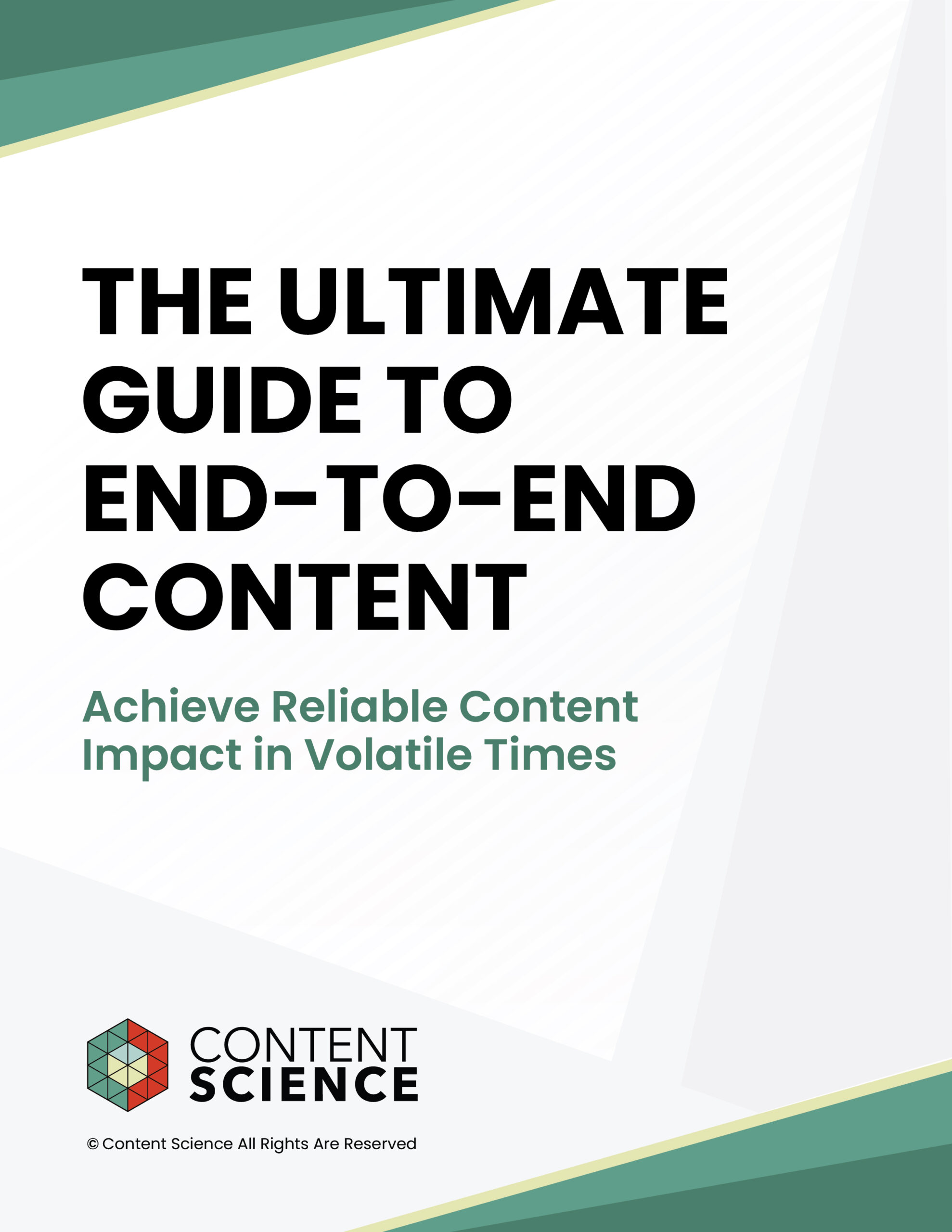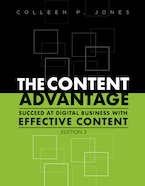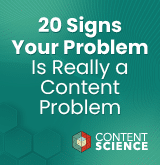
At Content Science, we find the real value of content for an organization is the content’s ability to achieve goals–in other words, its effectiveness. If content is highly effective with your customers or users, you usually sees a positive return on investment (ROI). This makes content effectiveness a strong indicator of ROI and underscores its relevance to your bottom line.
We also view measuring content effectiveness as an important part of a larger content intelligence system, which is one of three crucial systems in a comprehensive, end-to-end content approach.
So, is your content effective? If you don’t know the answer, your organization’s content probably isn’t as effective as you’d like it to be. The only way to know whether your organization’s content is effective is to start measuring it. This article will help you start or refine an approach to measuring content effectiveness.
A Definition of Content Effectiveness
We define content effectiveness this way:
Content effectiveness is the ability of content to enable your customers or users to achieve goals—while also achieving your goals.
Content effectiveness isn’t just for content marketing or product marketing. We find content throughout the end-to-end customer or user journey benefits from insights about effectiveness. We regularly see correlations between content effectiveness and customer satisfaction, engagement, adoption of self service, problem resolution rates, new feature adoption, and other important key performance indicators in a complete customer experience.
The 6 Dimensions of Content Effectiveness
What matters in making effective content? In our research, we identified six dimensions of content effectiveness, and these dimensions have held up over the course of collecting data from more than 150,000 people. The dimensions include
- Discovery: How do users discover content? Do users find the content they need easily or with difficulty?
- Accuracy: Do users perceive the content as accurate or trustworthy?
- Polish: Do users perceive the content to be at an appropriate level of quality and accessibility?
- Relevance: Do users perceive the content as serving their specific needs, interests, or situation?
- Usefulness: Do users perceive that the content enables them to achieve a goal or complete a task?
- Influence: Do users take action or make a decision after engaging with the content?
When we measure content effectiveness, we are taking these six dimensions into account. The Content Science team developed a tool called ContentWRX to help automate this assessment (including with artificial intelligence), from collecting data to creating a content effectiveness score. We also look at this complementary data when available from other sources:
- Web and channel analytics
- Voice of customer data
- Customer inquiries and sentiment
- Business metrics
Many companies collect some or all of these types of data when measuring effectiveness. But the challenge often comes with creating a content intelligence system to efficiently evaluate your content effectiveness so you can quickly take action.
How to Measure Your Content Effectiveness
When it comes to measuring effectiveness, where do you start? Here’s what you need to consider in creating your content effectiveness measurement system:
- GATHERING RELIABLE FEEDBACK on content, efficiently and regularly.
- ANALYZING THE FEEDBACK in a timely, consistent manner to glean insights.
- TRACKING THE INFORMATION over time to measure changes and results.
- COMPARING performance to industry benchmarks so you know where you stand.
- CONSULTING expertise, research and best practices to help interpret and act on the insights.
- PROMPTING ACTION through easy reporting and systematic reminders or alerts.
These tasks fit within three broad buckets of work:
- Data collection
- Analysis and interpretation
- Insight and action
Let’s briefly walk through how you can approach each of these three buckets to collect effectiveness measurements that are insightful and actionable.
Data Collection
This bucket of work is all about collecting useful data efficiently.
One tool will not collect all of the data. You will need an ecosystem of technology and tools that provide data related to content.
Web analytics are not enough. You also need voice of customer feedback, sentiment data, channel analytics, and more to understand what content is effective and why. As a simple example, the American Cancer Society uses an ecosystem of data collection and analysis tools including Google Analytics, ContentWRX, HotJar, and more.
Analysis and Interpretation
Collecting data alone is not enough to measure content effectiveness. You need to know what to do with that data. That’s where analysis and interpretation come in. These tasks require a combination of tools, people, and processes. And it begins with asking the right questions.
The right questions come from your business goals and content vision or strategy. The clearer your content vision and your strategy to achieve it is, the easier it will be to define appropriate questions.
Tools can help automate, but humans have to be involved. People need to define priorities for analysis, set up the tools, oversee the implementation and help assess the interpretation.
If you and your team and stakeholders are not meeting regularly to review your questions about content and the analysis intended to answer them, you will not be able to gain insight or take action. Consider including this activity in the charter of a center of content excellence.
Insight and Action
If you successfully collect high volumes of content data but never learn or act on the information, you might as well have no content data at all. You need to be able to uncover useful insights and make decisions about your content and much more.
For example, Intel uses a robust set of data about content effectiveness to decide how to streamline its digital presence—in other words, reduce its content bloat. This intelligence has helped the technology giant consolidate in the short term and set a best practice for ongoing digital governance so that such an extreme case of content bloat never happens again.
As another example, a large home improvement retailer used data from ContentWRX and other sources to drive new content standards and structure for optimization. The result? A 753% increase in attributed revenue after one year.
Understanding content effectiveness is the foundation for other content insights and actions. For example, it’s difficult to calculate a return on your investment in a content product or your return on content assets without understanding how effective your content is.
Having enough content data and analysis to make predictions and decisions takes time. The sooner you implement a content effectiveness measurement system, what we call a system of content intelligence, the sooner you or your artificial intelligence can start predicting the impact of content changes.
Bottom Line
How do you answer the question of whether your content works and what to do about it? Without a steady stream of feedback about content from your customers, you can’t.
The lessons learned from assessing whether your content is effective can help you improve your current approach, develop new content ideas, solve problems (content problems and other organizational challenges, like improving customer experience or achieving digital transformation), and much more.
If you’re ready to start measuring content effectiveness, you can use our Content Effectiveness Measurement Worksheets [subscriber access required] and read about how to benchmark your content effectiveness using ContentWRX to connect your content with real results.
Events, Resources, + More
The Ultimate Guide to End-to-End Content
Discover why + how an end-to-end approach is critical in the age of AI with this comprehensive white paper.
The Content Advantage Book
The much-anticipated third edition of the highly rated book by Colleen Jones is available at book retailers worldwide. Learn more!
20 Signs of a Content Problem in a High-Stakes Initiative
Use this white paper to diagnose the problem so you can achieve the right solution faster.
Upskill with Content Science Academy
Training for modern content roles through on-demand certifications + courses or live workshops.






Comments
We invite you to share your perspective in a constructive way. To comment, please sign in or register. Our moderating team will review all comments and may edit them for clarity. Our team also may delete comments that are off-topic or disrespectful. All postings become the property of
Content Science Review.